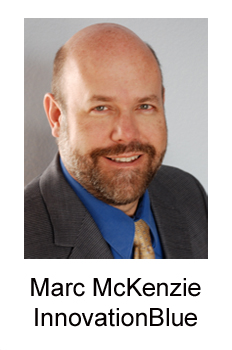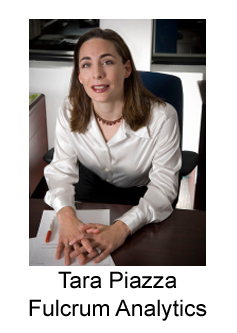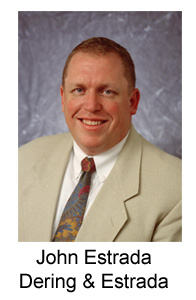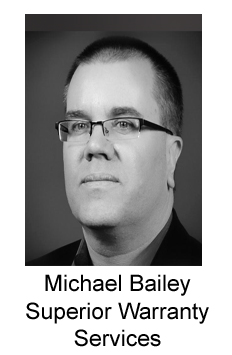WCM Conference, Part Two:
Even just the highlights expected over the course of the three days would take a month to detail. So here are just some of the themes and topics selected by the warranty experts headed to San Diego next week.
With less than a week before the opening of the seventh annual Warranty Chain Management Conference in San Diego, we're getting down to the inevitable choices that people need to make about what to see and who to watch.
Allison Griffiths, the president of ALG Associates LLC and the WCM conference director, has planned an incredibly diverse program of events that at most times of day gives attendees a choice of four different tracks to visit.
Numerous manufacturers will speak about their own experiences and lessons learned. Top extended warranty company executives will debate the future of their industry. Several attorneys will detail the impact of various new laws and regulations. And most of the top warranty software and service providers will not only exhibit their wares but also will help train their prospects on how to become more discerning customers.
Best of all, Griffiths said the halls will be packed. So far, she has 310 registered attendees. And therefore, with a few more days for online registrations plus the inevitable on-site walk-ups expected in San Diego, the 2011 event is on track to either tie or surpass the levels set in 2008.
To be sure, there are a lot of speakers on the agenda for this year who were there in both 2009 and 2008. But in almost every case, they're taking their presentations to the next level, providing either an update on new developments or a deeper look at some aspect of what they've presented previously.
To the Next Level
For instance, last year Sheila Cardines of Caterpillar Inc. delivered a report on the first and second years of what she called a five-year journey of warranty improvement. This year, she'll go over some of the highlights of the third year. Last year, Michael Paczolt of Milliman Inc. gave a talk he called "Actuarial Science 101." This year, he'll expand on just one section of that presentation, taking a detailed look at how to account for warranty goodwill costs and what it might be worth to a company.
Paul Sonderegger, chief strategist for Endeca Technologies Inc., opens the conference with a keynote presentation entitled, "Discretion as Competitive Advantage: The New Role of IT in Warranty and Quality."

For him it's also a return engagement of sorts -- a more in-depth follow-up to a very well-received presentation he delivered at last year's conference in Los Angeles which was written up in the March 25, 2010 edition of Warranty Week.
"We have a great story to tell this year," Sonderegger said. "And the story really is about choice, and the wealth of information that the warranty and quality processes create to inform choices further to the front of the value chain."
For instance, design engineers can use warranty data to monitor actual products in the field, and channel that information into the improvements they plan for the next generation. Quality engineers can look at warranty data to help them tell the difference between failures caused by bad designs, bad parts, or bad manufacturing processes. And at least with the latter, they can make improvements that have an immediate effect on claims rates.
Bringing Together Information
Sonderegger said his focus this year will be on how warranty professionals in the automotive, aerospace, and high-tech electronics industries can make those choices to the benefit of their companies. It's not just about passenger cars or just about early warnings and recalls.
"This story really is about bringing together the diversity of information that may affect choices up and down the value chain, which ultimately lead to higher quality and lower warranty," he said. "But the real point of this idea of internal information markets is that while a single version of the truth is very tempting, it is a very narrow way to look at the world."
It's the diversity of data and of data sources that gives the best view, he said. There are numerous valid perspectives to take when handling the cost of warranty. But automation has attempted to drive out that variability caused by human factors.
"How can we reintroduce human choice? How can we reintroduce discretion and judgment into these standardized processes at the scale of modern organizations? And we believe internal information markets are the way to do it," he told Warranty Week.
For instance, Sonderegger said that during last year's WCM conference, a warranty professional at an aerospace company told him a story about the recent redesign of a sensor that is typically attached to the outside of a fuselage. "The physical chassis was more closely integrated with the circuit board that actually handles all the data coming off the probe," he said. And that cut manufacturing cost significantly.
But warranty claims soared, and the company couldn't figure out why. It didn't seem to be a problem with the parts or with the new design. It wasn't a problem with the suppliers or with the components they supplied. So what was it?
Making a New Step Stool
"It turns out that all along, aircraft technicians were using this thing as a step," he said. And while the old units could survive such misuse, it doomed the new units. So the manufacturer had to decide whether to absorb the cost of frequent replacements as a goodwill gesture, or to deny the claims because of customer abuse.
Engineering might prefer to make one choice, while marketing might prefer another. And wherever such a decision needs to be made, there is a demand for information to help make it -- in this case, that the redesign made the probes more susceptible to damage. But there is always a problem with the supply: it's scattered, it's diverse, and it's always changing.
"The objective of internal information markets is to dramatically reduce the cost of making a better choice," Sonderegger said. "It's the market part that is key. These are information markets inside of companies. And it may include information created by the company itself, by its partners, by its suppliers, by its distribution network, and even by its customers."
Especially with warranty claims, the problem with automation is that so many incidents are unanticipated. They involve human behavior, and they depend on human explanations. Did those claimants admit to stepping on the probes? Probably not. And did the probe's redesigners know they were also making step-stools? Definitely not.
Consumer Information Retrieval
Sonderegger said there's something to be said for an information exchange. And he points out that some of the largest databases ever created -- by companies such as eBay, Amazon.com, and Google -- are readily useable by typical consumers. So any successful attempts to build an internal information marketplace will necessarily have to do a better job of building the interface and making it useable.
Some of those consumers are now growing up and entering the workforce, with a valuable new set of skills concerning data retrieval and use. And they won't accept that simple questions such as why something happened can't be answered because some of the systems aren't connected. They won't accept the fact that it would be easier to use their smart phone applications to ask Google a question than to go looking internally within their company for an answer.
Sonderegger suggests that people who want to get a jump on their peers and gain a deeper understanding of this whole "internal information markets" concept should take a look at a five-minute online video discussion about decision support and competitive advantage delivered by him and Harvard Business School professor (and Endeca board member) Michael Porter.
But even before Sonderegger's keynote speech during the morning of March 16, there will be valuable presentations about how to put warranty information to work. On Tuesday, March 15, there will be three pre-conference workshops: two in the morning and one in the afternoon. And then that evening at 6pm, there will be an annual meeting of the Institute for Warranty Chain Management in the Mission III room of the Hyatt Regency Mission Bay.
Warranty Workshops
The morning workshops are "Extended Service Contracts �- Keys to Success," presented by Terry Hawkins, an independent consultant recently retired from Assurant Solutions, and "Taming Warranty Costs at New Product Release and Product Launch," presented by consultants Fred Schenkelberg and Marc McKenzie. The afternoon workshop is entitled simply "Warranty Chain Management Analytic Workshop," and will be presented by Bill Roberts and Josh Becker of SAS Institute.
McKenzie noted that both he and Schenkelberg used to work at Hewlett-Packard, "and we never met while we were in HP. But he's a really fine and respected engineering manager," he added. "So I feel honored to work with him."

The topic for this workshop, McKenzie said, grew out of a "design for warranty" and "customer self-repair" presentation he and others participated in at last year's WCM Conference. This workshop looks at how a company can reduce warranty costs even before a product is launched, for instance by making it easier to use and/or easier to fix.
The work starts with the invention or the revision of the technology, he said, whether it's an airplane or an air conditioner, and carries on right through all the milestones and checkpoints along the way. That's the best place to reduce cost, by either averting failures or making them easier to repair.
The worst place to try to reduce cost, he added, is after the product is sold, perhaps by finding the least expensive call center on the planet or by finding new and innovative ways to blame failures on customer abuse or misuse.
Making Better Products
"Service costs have to be managed," he added. "I'm not saying they shouldn't be. I'm just saying it would be better if you made a better product to begin with."
But how do you know? The theme of the past decade or so is how frequently completely new product categories or features have been invented: wireless phones with Internet access and built-in cameras, ovens that can be turned on or off using the web as a remote control, or electric cars that plug in and charge overnight. How do you predict the warranty cost of something you've never sold before?
Schenkelberg plans to talk a bit about HALT and HASS, the Highly Accelerated Life Test and the Highly Accelerated Stress Screen that can actually provide clues about how a brand new product will age and perhaps even how it is likely to fail. Products are subjected to all sorts of environments, stresses and perils, such as a hot room, a cold room, or a vibration room, just to see what happens. So you find out what fails long before you build and ship a million units.
"And then you keep evolving your model," McKenzie said. "You might run a little pilot, or you might have some early warning failure analysis. And that's how you can start managing your accrual changes too. You can actually change your existing reserves that way, and either increase or release part of your reserves around that."
But back to the workshop. This event is more for the designer or the engineering manager interested more in the science than in the finance of the warranty process. And it could be a priceless means to expose some senior executives to the concepts behind quality management and design for warranty, so they can support such efforts within their own companies.
Extended Warranty Workshop
If you want to talk about money, move down the hall to the extended warranty workshop hosted by Terry Hawkins. At last year's WCM Conference, Hawkins and Assurant Solutions' Michael Yates delivered a standing-room-only performance that detailed all the moving parts of an extended warranty program, how it should be managed, what should be measured, and how the partners at the various levels of sales, administration and underwriting should work together.
This year, he said he plans to delve a little more deeply into some of those topics. But more than anything, Hawkins said he wants to transfer some of his knowledge about the warranty and service contract business to some people who need to know but don't know who to ask.
And then there will be an enormous amount of knowledge transfer taking place during the two days of the actual conference, on Wednesday and Thursday. During a Wednesday morning panel that's otherwise dominated by legal and regulatory updates on the extended warranty industry, Tara Piazza, the vice president of customer research at Fulcrum Analytics Inc., plans to deliver a statistical rationale about why manufacturers need to get more deeply involved with extended warranties.
Entitled "Consideration of Extended Service Contracts: A Study of Consumer Opinion," Piazza's presentation is based on a February 2011 survey 1,161 consumers who recently purchased a printer, copier, digital camera, camcorders, flat panel TV, refrigerator, washer, motorcycle, ATV, boat or passenger car.

Piazza said the research study proves that there's more to extended warranties than just the additional revenue they bring in. They also can build trust in the brand, boost customer loyalty, and can actually convince buyers to extend their time of ownership.
In fact, many respondents said they would rather buy an extended warranty from the manufacturer than from the retailer or from a third party. Depending upon the product, between 71% and 85% of the extended warranty prospects would "strongly prefer" the manufacturer to sell it to them or "would buy only from" the manufacturer. Only 5% to 15% said it didn't matter to them who made the offer.
Follow the Money?
In contrast, some manufacturers think it's all about the money -- that it's all about selling something that customers don't need and won't use, to boost the seller's profitability. And there seems to be a stigma attached to their sale, supported and nurtured by a mountain of "don't buy them" advice columns in major newspapers.
"What we hear, especially from manufacturers that don't have extended warranty programs, is that they fear that introducing an extended service contract program gives the impression that their product needs that -- that there's some product quality issue," Piazza said. "We've heard that more than once, that people hesitate from opening that kind of a program because of that fear of creating a negative perception."
In contrast, her research details how that's just not so. For instance, while two percent of camera buyers said the knowledge that a manufacturer offers extended warranties made them "much less secure" or "somewhat less secure" about their purchase, 50% said it made them feel no different, and 48% said it made them feel "somewhat more secure" or "much more secure."
Other responses asked product buyers if they've bought extended warranties in the past, and if they did, if they ever had to make a claim. And of course, the survey also asked them how satisfied they were with the product, with the extended warranty, and if applicable, with the claims process and results.
As has been confirmed in numerous other instances, Piazza's survey found that customer satisfaction is actually highest after a successful break-fix episode. "You actually will have more loyal customers if something goes wrong and it's promptly fixed, as opposed to if nothing went wrong in the first place," she said. But it fell to the lowest level following a disastrous break-fix episode.
Building Brand Loyalty
The lesson there is that the manufacturer can actually benefit from getting involved with a repair, be it a warranty claim or an extended warranty claim. But there's also a lesson in terms of even if the manufacturer is not involved, and a retailer or a third party does a horrible job, the manufacturer will probably get blamed anyway, and they'll lose the customer's brand loyalty through no fault of their own.
Let's be clear: in the extended warranty industry, a book of business that's breaking even or losing money is an awful sight. But Piazza added that even if it were merely breaking even, other advantages would accrue to the manufacturer who sold them. In fact, some of those benefits accrue even if the customer doesn't buy the service contract. They just want to know they could.
"People have a greater sense of security about the purchase, knowing that there is an extended service contract available, should they want to pursue that," Piazza said. "And people do think, for the most part, that it will lengthen their time of ownership. So those are two benefits to the customer that add value to their product purchase whether or not they even buy the extended service contract."
Piazza added that those who can't make it to her panel discussion can stop by the Fulcrum exhibit booth to pick up a free handout. And she said she plans to answer tons of questions and deliver kilos of explanations during the breaks between tracks.
Service Intelligence
During that same 10:30am to 12:30pm slot in another room, the discussion will be around how manufacturers can simplify and streamline the warranty chain management process. Roshan Pinto, the director of the service operations practice at Tavant Technologies, will be joined by Manoj Goel, the warranty czar at Cisco Systems; Kjell Hammarstrom, the sun king of Oracle Corp.; and Robert Mueller, the training kaiser of the Institute of Warranty Chain Management.
Pinto is taking the place of Devendra Malekar, who had to stay home in India. His presentation is entitled, "Cross-functional Warranty Management �- A Closed Loop Approach to Boost Profitability." He said it's focused primarily on how to use warranty management technology to reduce the cost of warranty and the cost of poor quality. And it's aimed at warranty administrators, quality managers, and business process improvement types, he added, especially those in the heavy equipment and HVAC industries.
"We talk about automation, and we talk about monitoring warranty performance, and we look at how basic service intelligence helps you tie all of this together," Pinto said.
The cross-functional aspect, he said, looks at how different parts of the company should communicate regarding warranty matters. For instance, while the quality people are looking at defects per thousand units, the financial people need to translate that into an accurate cost projection in dollar terms.
"And then, purely from a quality standpoint, how do you ensure that what's found on the shop floor and what may be reported directly there, gets back into your ability to manage warranty better?" Pinto asked.
The closed loop approach, he said, looks at how to tie it all together. "When you're talking about service intelligence, it's not really limited to talking about how it works from just a warranty standpoint," he said. "You really need to include all of these different groups that are involved, to find out the true cost of poor quality."
Outsourcing vs. In-Sourcing
From 3:45pm to 5:30pm on Wednesday, one of the four parallel tracks is entitled, "Transforming, Outsourcing & Profitability." John Estrada, founding partner of Dering & Estrada and a co-founder of ServiceBench Inc., said he helped to put the panel together as a way to present a range of options: outsourcing, in-sourcing, and a hybrid of the two.

"One of the key things in this track is how it will give people a chance to see options and opportunities on how to improve their warranty processes from beginning to end," he said. Hopefully, it will convince each attendee to realistically evaluate what their companies do really well, and what they would be better off giving over to some outside experts.
"Back in my days at ServiceBench, I used to talk with people about that all the time," Estrada said. Some companies are best-in-breed at certain tasks, but not at every task. Yet some think they can be. "Especially with a small manufacturer, you can't differentiate yourself across the entire aftermarket space. You need to pick and choose your battles," he said.
Improving Warranty Registrations
The track begins with a presentation from Vinay Anne, a co-founder of Registria Inc., who will talk about how to improve warranty registration rates and how to use that customer information internally to improve the warranty process.
Imran Masood, the BPO business leader at Cognizant Technology Solutions, will then step up to give a presentation entitled "Warranty Outsourcing for Strategic Gain." He said that while he will discuss the outsourcing of all or part of the warranty process, he will concentrate on how such a customer should measure and compare their outsourcing providers.
"What is it that you need to look for in such a relationship?" he asked. For example, there are four or five standard metrics one uses when evaluating a call center. But what about other sectors of the aftermarket?
Masood said numerous companies already have or about to outsource various elements of their warranty process. But at the same time, the warranty process generates valuable data and relationships that can benefit those same companies, if the outsourcing service collects and reports it appropriately.
"So how do you ensure that you set up the relationship so that the value is not lost, and that value continues to be delivered?" Masood added.
Focusing on Warranty
Cognizant, which was spun off from Dun & Bradstreet in 1994, has an extensive track record in business process outsourcing across industries such as health care, insurance, and banking, as well as industry-specific solutions such as supply-chain management services for manufacturers. In recent years, it has begun to focus more specifically on aftermarket services and specifically warranty.
"Our manufacturing practice has eight to ten thousand people," Masood said. "We maintain a ton of in-house applications that people have for warranty management. We do a ton of analytics for big brand U.S.-based auto companies. So our understanding of this space and our ability to contribute value is coming from that practice and that heritage."
After Masood's talk on outsourcing, Estrada will lead a panel discussion about what to do to prepare for a warranty system deployment, which will include both Anne and Masood as well as Louis Rose from NEW Customer Service Companies Inc. (and also a ServiceBench co-founder), and Michael Bailey, president of Superior Warranty Services and a consultant for 4CS Inc.
Bailey said he plans to talk about what goes into a typical warranty system implementation, particularly in terms of making sure the right people are involved. "So often, key groups are left out of the decision-making process, or the requirements process," he said. Therefore, he plans to emphasize the importance of making sure that doesn't happen, for instance by bringing in people at the supervisor level instead of just top executives (who may not know what goes on "in the trenches").
Automating Best Practices
Another key point Bailey said he plans to make is to avoid the automation of bad processes. "We don't want to walk in and automate your manual processes unless those manual processes are best practices or must haves for your business," he said. "We don't want to replicate today's processes and systems, and automate then for cost savings and for better reporting, if we can also look at better ways to run the business."
And then there's the question of where you want to go in the future? Do you want to get involved in data mining? Do you want to use that customer data to drive sales of accessories, supplies, or extended warranties? Decisions you make now could either allow or preclude such expansions.

However, Bailey said he isn't going to tout in-house systems and dismiss outsourcing, just because of his current association with 4CS. As he plans to say in his other presentation (on Thursday, March 17 from 10:15am to 12:15pm), it really depends on what kind of company you are, what you have in-house already, what you make, and how it's sold.
"You really have to look at it on an individual basis," he said. "There is no 'here's a one-brush answer.'"
For instance, if you're a manufacturer and you're looking at getting into extended warranty direct sales, you should already have a fairly robust product warranty claims processing system in-house. But if you're a retailer, there may be very valid regulatory and financial reasons why you would never want to retain the risk on your books, no matter what kind of systems you use.
Questions and Answers
Hopefully, the discussion will be as balanced and even-handed as possible, looking at the advantages of in-house systems, of outsourced services, and of a combination of the two. If not, hopefully the audience will have some probing questions ready.
"I think it could really help companies as they prepare to make changes, whether it's through new systems or through outsourcing," Estrada said. "It's for companies that are looking to improve their processes, to look at potentially new technologies, new methods, or new experiences that can be provided through working with other companies that are experts in this particular area. I think that's one of the big pluses in the people in this track: they're real experts in their individual fields, and they can help give you insight into how to take advantage of that, whether [you're buying] from them or from other vendors."










